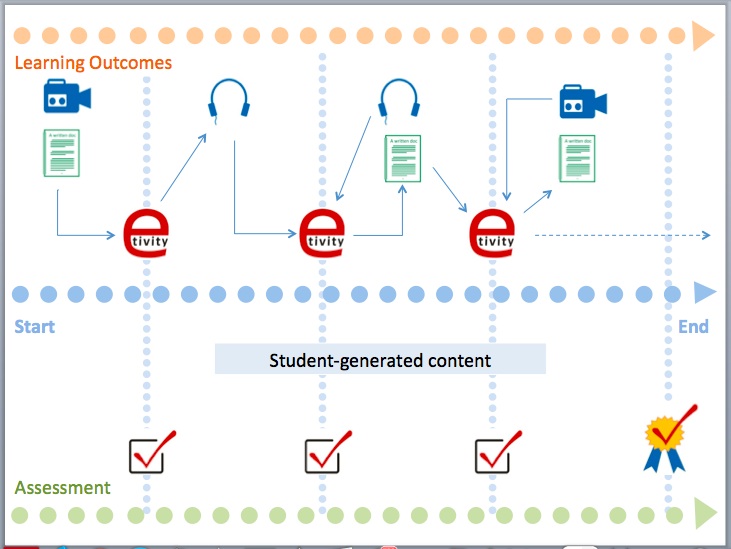The origins of storyboarding are within the film industry, where it was popularised by Walt Disney Productions during the early 1930s. In this context, a storyboard is a graphic organiser in the form of images displayed in sequence, to pre-visualise a motion picture, animation or interactive media sequence.
Storyboarding in learning design
Storyboarding is the process that learning designers use to map out the core elements of a course.
It is a structured way of representing the sequence of outcomes, resources, activities and assessments in a course. It is a means of representing the overall way in which a course is organised, and how the different elements are sequenced and fit together. The order of sub-elements of the storyboard is typically informed by one or more instructional design models.
Storyboards often include the specification of media resources (eg video, audio, graphics…) that will be incorporated into the learning sequence.
In an organisational context, storyboarding usually commences after the approval of the design blueprint (a high level master plan for a new course), but before authoring of the materials begins.
Storyboards can be written, graphic or a combination of both.
Storyboards can be developed at the course level, showing the sequence of learning for the planned duration of the course. They can also be developed at a micro-level, showing the sequencing of elements within a learning pathway.
Example of a mini-course level storyboard
The following storyboard example provides a visual overview of a four-week course, including the learning resources and activities for achieving the learning outcomes, as well as an assessment strategy for both formative and summative assessment[1].

In this example, the four columns represent four weeks, with one topic focus per week:
- During week 1, learners watch a video and read a paper to complete an e-tivity (online activity) and write an essay, which is assessed. The teacher provides formative feedback.
- In week 2, learners listen to a podcast, read a paper and write a reflective blog post. Other learners comment on this post.
- In weeks 3-4, learners read more papers, listen to a podcast and watch a video. They might do a group presentation and write an essay. The teacher undertakes a summative assessment.
In practice, storyboards are developed using a variety of tools, from flipcharts to web-based technologies.
Acknowledgement
- ↑ The original version of these materials was developed by Gabi Witthaus and Brenda Padilla for the Storyboard for Storyboarding open course under a CC-BY-SA licence.
The origins of storyboarding are within the film industry, where it was popularised by Walt Disney Productions during the early 1930s. In this context, a storyboard is a graphic organiser in the form of images displayed in sequence, to pre-visualise a motion picture, animation or interactive media sequence.
Description
Storyboarding in learning design
Storyboarding is the process that learning designers use to map out the core elements of a course.
It is a structured way of representing the sequence of outcomes, resources, activities and assessments in a course. It is a means of representing the overall way in which a course is organised, and how the different elements are sequenced and fit together. The order of sub-elements of the storyboard is typically informed by one or more instructional design models.
Storyboards often include the specification of media resources (eg video, audio, graphics…) that will be incorporated into the learning sequence.
In an organisational context, storyboarding usually commences after the approval of the design blueprint (a high level master plan for a new course), but before authoring of the materials begins.
Storyboards can be written, graphic or a combination of both.
Storyboards can be developed at the course level, showing the sequence of learning for the planned duration of the course. They can also be developed at a micro-level, showing the sequencing of elements within a learning pathway.
Example of a mini-course level storyboard
The following storyboard example provides a visual overview of a four-week course, including the learning resources and activities for achieving the learning outcomes, as well as an assessment strategy for both formative and summative assessment[1].
In this example, the four columns represent four weeks, with one topic focus per week:
In practice, storyboards are developed using a variety of tools, from flipcharts to web-based technologies.
Acknowledgement
Project lead
Supported by
Development Partner